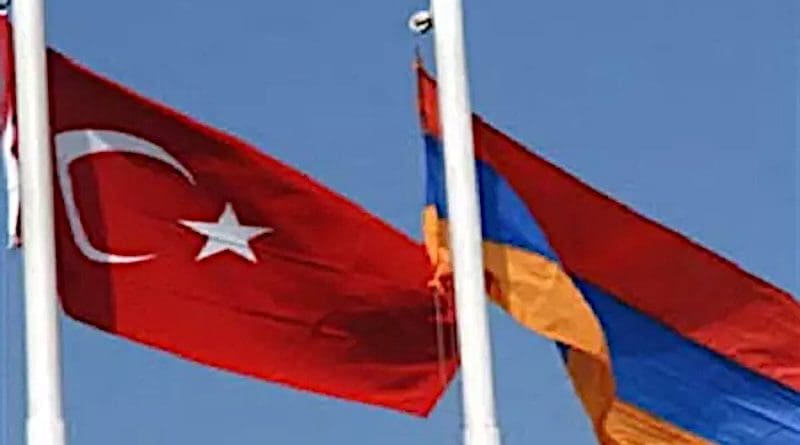In Turkey ‘People Are Rebelling’ Against Armenia Genocide Denial
By Lou Ann Matossian
As Armenians in Yerevan laid flowers at the Eternal Flame on the 95th anniversary of the Armenian Genocide, Turkish citizens in Istanbul solemnly commemorated April 24 with candles and red carnations-despite protests from ultranationalists and the denial policy of their own government.
Seated on the steps outside Haydarpa’a Station, activists from the Istanbul Human Rights Association held carnations and posters of Armenian community leaders whose arrest and deportation from that very place had heralded the Young Turks’ extermination campaign. “April 24, 1915-Never Again” proclaimed the organization’s banner as human rights attorney Eren Keskin addressed the solemn group.
“The events of 1915 must not be repeated,” Ms. Keskin was quoted in press reports. “We have gathered here to say no to genocide.”
Turkish police stood guard at the peaceful demonstration of about 100 mourners, keeping counter-demonstrators at bay. As journalists’ cameras clicked and whirred, Ms. Keskin and the others threw their flowers into the Bosphorus, closing the vigil on the Asian shore of Istanbul.
That same evening in the heart of downtown, on the European side, the Initiative to Say No to Racism and Nationalism held a peaceful sit-down demonstration in bustling Taksim Square.
A large black placard, inscribed “This is OUR pain. This is a mourning for ALL OF US,” in Turkish, Armenian, and English, was placed on the ground with bouquets of red carnations and rows of votive candles resembling red apples.
“In 1915, when we had a population of only 13 million people, there were 1.5 to 2 million Armenians living on this land,” an organizer proclaimed in Turkish. More than 200 mourners sat in silence as she named the cities and regions where Ottoman Armenians had lived, from Kars in the east to Thrace in the west.
“They were the grocer in our neighborhood, our tailor, our goldsmith, our carpenter, our shoemaker, our farmhand, our millwright, our classmate, our teacher, our officer, our private, our deputy, our historian, our composer…our friend,” the statement continued. “Our next-door neighbors and our companion in bad times.
“On April 24th, 1915, they were ‘rounded up’. We lost them. They are not here anymore. A great majority of them do not exist anymore. Nor do their graveyards,” the organizer read out, evoking “the overwhelming ‘Great Pain’ that was laid upon the qualms of our conscience by the ‘Great Catastrophe’.”
Clark University professor Taner Akçam, an endorser of the Taksim Square statement, called the April 24th commemorations in Turkey a “serious crack in the wall” of silence and denial. “The other Turkey-the Turkey that doesn’t belong to denialists-is coming to the surface,” he told the Armenian Reporter.
“People are rebelling,” he concluded. “They are saying, ‘We want to learn the truth’.”
Without identifying the Armenian Genocide as such, the statement urged “all peoples of Turkey who share this heartfelt pain to commemorate and pay tribute to the victims of 1915.” (The full text, posted online at buacihepimizin.org with some 1,500 signatures, was endorsed by about 80 prominent intellectuals and activists in Turkish society.)
Shouts of “Death to the Armenian Diaspora!” could be heard from counter-demonstrators as the mourners paused in silent commemoration, reported an eyewitness, Armenian Weekly editor Khatchig Mouradian. “This is Turkey! Love it or leave it!” chanted a group of angry men from behind police lines, in a video shot at the scene and posted to YouTube. Haranguing the mourners as traitors, they extended their first and fourth fingers in the ultranationalist Grey Wolf gesture.
At the close of the vigil, the mourners tossed carnations into the air, reported Hürriyet. “The brotherhood of Armenians, Turks, and Kurds!” they chanted, marching down Istiklal Avenue. “Shoulder to shoulder against fascism!”
Additional public vigils were reportedly held in Galatasaray, not far from Taksim Square, by Kurdish mothers of “disappeared” children, and outside the offices of Agos Armenian newspaper, where editor Hrant Dink was gunned down in January 2007.
A reparations debate in Ankara
In Ankara, meanwhile, international scholars and writers participated in a two-day conference on “1915 within its pre- and post-historical periods,” organized by the Ankara Freedom of Thought Initiative. Nearly cancelled due to political and bureaucratic obstacles, the panels were held under tight security, with no counter-demonstrations permitted. Unusually for a conference in Turkey, proponents of the government’s “official history” were notably absent from the list of invited presenters.
Nevertheless, a panel on “The Armenian Issue: What is to be done and how?” sparked plenty of controversy as Worcester State University philosopher Henry Theriault called for genocide reparations. Turkey should return or compensate for Armenian property, wealth, slave labor, pain and suffering, and the loss of 1.5 million people, as well as cultural, religious, and educational losses, Prof. Theriault stated.
Although Sevan Nishanian of Agos newspaper flatly rejected these demands as unjust and unproductive, author Temel Demirer and Welsh writer-activist Eilian Williams defended them, according to The Armenian Weekly’s Mouradian, who participated in the intense debate among the panelists and audience members.

